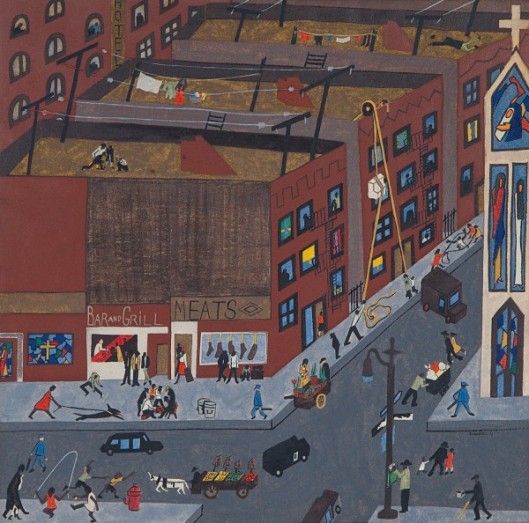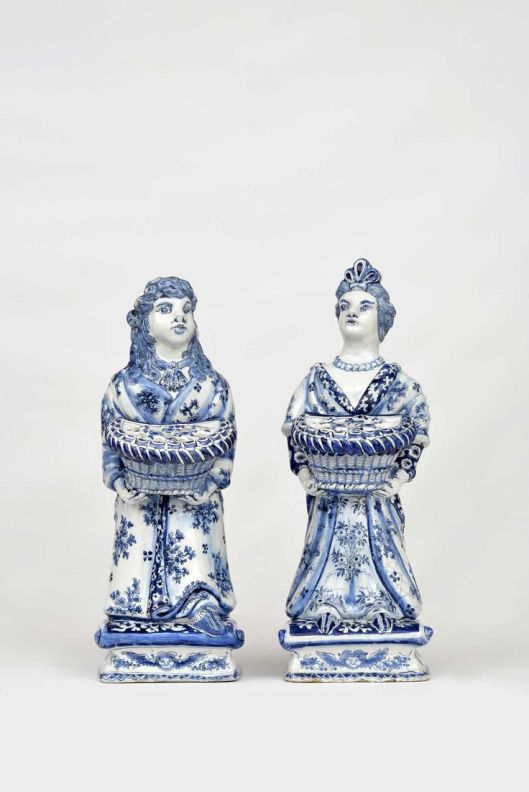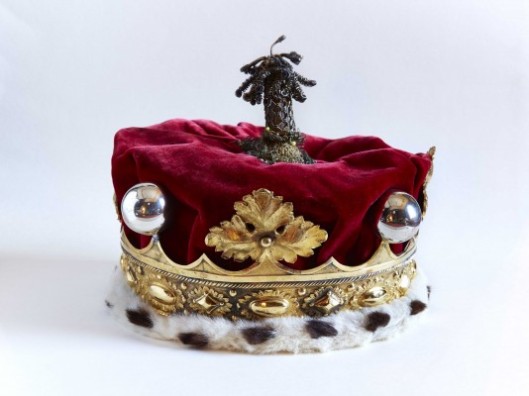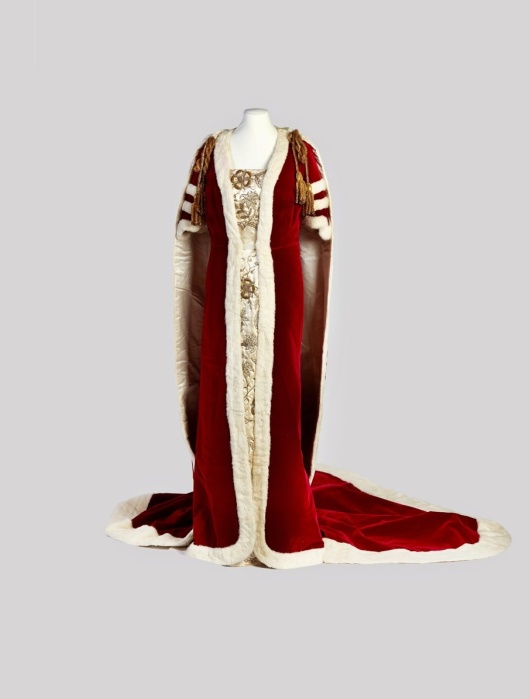OXFORD.– A fascinating selection of early vernacular furniture and works of art is to go under the hammer at Bonhams Oxford, in ‘The Oak Interior: including the Collection of Roger Rosewell FSA of Yelford Manor, Oxfordshire’, on 21 January 2015.
An impressive oak and marquetry inlaid tester bed, dating to the late 16th/early 17th century and estimated at £8,000-12,000, is a highlight of the sale, and comes from a 130-strong collection of pieces from Yelford Manor, former property of the medievalist and writer Roger Rosewell.

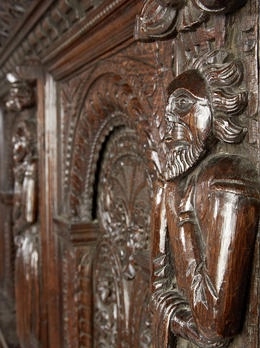
An impressive oak and marquetry inlaid tester bed. Elements late 16th-early 17th century. Estimate £8,000 – 12,000 (€10,000 – 15,000). Photo Bonhams.
The tester with six deep recessed panels, each within a carved and dentil-moulded frame and centred by applied geometric inlaid mounts, the headboard with a pair of finely arch-carved panels flanked by figurative terms, headed by delicate floral marquetry, inlaid initials RM over EM and the date 1605, each end-post with a large bulbous cup-and-cover turning supporting a strap-work carved tapering Corinthian pillar, all raised on stiff-leaf carved plinths,(mattress size 5ft x 6ft 2in); 169cm wide x 219cm deep x225.5cm high, (66 1/2in wide x 86in deep x 88 1/2in high)
Provenance: Purchased Mary Bellis Antiques, Hungerford, Berkshire, 17 September 1986.
Other items from Yelford Manor include:




A rare and impressive James I oak panel-back open armchair, Somerset, circa 1625. Estimate £6,000 – 8,000 ç€7,500 – 10,00). Photo Bonhams.
With notable back rack, the arch-enclosed ornately floral-carved back-panel below a characteristic deep and similar carved top-rail, the carved and pierced cresting of two well defined scrolls, the back-uprights each carved with a single stylized stiff-plant above the downswept arm, the boarded seat with moulded edges wrapping around the underarm supports, the seat-rails typically carved with lunettes, raised on inverted-baluster turned legs joined by plain stretchers,72cm wide
Provenance: Purchased Mary Bellis Antiques, Hungerford, Berkshire, 15 November 1982.
Literature: A near identical chair illustrated Victor Chinnery,Oak Furniture: The British Tradition, (1993), p. 455, fig. 4:81; and a similar example, fig. 4:82. The author makes reference to the enriched arch found here and in general the high-quality carved furniture to be found in the area, which may be attributed to the cathedral city of Wells, or more likely to nearby larger regional centres such as Bristol. See pages 454 – 457.
See also Oak Furniture from Gloucestershire and Somerset, exhibition catalogue, St. Nicholas Church Museum, 2 April – 1 May 1976 and Stable Court Exhibition Galleries, Temple Newsam, Leeds, 12 May – 12 June 1976, (nos. 20 & 21).


A James I oak and inlaid court cupboard, circa 1620 and later. Estimate £3,000-5,000 (€3,800 – 6,300). Photo Bonhams.
The strap-work carved frieze to three sides, raised on Ionic capital cup-and-cover turned column supports each profusely leaf carved, enclosing a pair of cupboard doors each with complex geometric line inlaid decoration within a deep cushion moulded S-carved frame, the conforming central fixed panel centred by an ebonized boss, a pair of triple-panelled cupboard doors below, each with lunette-filled carved upper panel and two knot-pattern inlaid panels, the knot-pattern design repeated on the top side panels, restorations 141.5cm wide x 54.5cm deep x 167.5cm high,(55 1/2in wide x 21in deep x 65 1/2in high)
Provenance: Purchased Mary Bellis Antiques, Hungerford, Berkshire, 18 October 1984.
Literature: This cupboard is illustrated Percy Macquoid, A History of English Furniture – The Age of Oak, (1925) p. 153, fig. 127. It is noted as the property of Messrs. Gill and Reigate, and dated to 1618.

A large, finely cast and important Commonwealth leaded bronze mortar, dated 1659, made for Francis Keble of Burford, Mercer [1637 – 1686], by Edward Neale of Burford [fl. c. 1640 – 1695]. Estimate £8,000 – 12,000 (€10,000 – 15,000). Photo Bonhams.
The rim with wire mouldings above a band of delicate ‘S’-scrolls and crosses, above the maker’s mark for Edward Neale, a chevron between three bells, flanked by the initials ‘EN’, between a pair of angular bead-embellished lug handles, above further wire mouldings and the inscription ‘I WAS MADE FOR FRANCIS KEBLE 1659’, all spaced by a line of three triangular pellets, two cord mouldings below, the foot with recessed flange, 36.5cm rim diameter x 27.5cm high (14 3/8in rim diameter x 10 13/16in high)
Provenance: – Francis Keble of Burford [1637 – 1686]
– Thence to the collection of J. H. Fitzhenry, Esq. [d. 1912]
– Sold Christie’s, 18th – 24th November 1913, Lot 603, and purchased by a Mr Sutton
– Thence acquired by Arthur G. Hemming, chemist and scholar of English mortars, before 1929
– Sold Sotheby’s, 22nd April 1988
– Thence to the collection of John Fardon, and soldChristie’s, 1st May 1996, Lot 239
– Thence to the collection of Michael Finlay
– Purchased by the current vendor in November 1997
(one of six named and dated 17th century English mortars in Mr. Rosewell’s collection)
Exhibited: – With the Victoria & Albert Museum, 1892 – 1902 (on loan from the Fitzhenry Collection)
Illustrated: – Arthur G. Hemming, ‘Dated English Bell-Metal Mortars’, in Connoisseur (March, 1929), 166, No. IX.
– P. Hornsby, Collecting Antique Copper & Brass (1989), p. 14, Figure 6.
– M. Finlay, ‘Who was Francis Keble?, in The Journal of the Antique Metalware Society Volume 7 (June, 1999), 35 – 38.
– M. Finlay, English Decorated Bronze Mortars & their Makers (2010), Colour Plate 6a.
Francis Keble of Burford: Francis Keble’s biographical details are discussed in Michael Finlay’s 1999 article (cited above). Francis Keble is believed to have been born to Toby and Mary Kibble and baptised on 24th August 1637 at All Saints, Gloucester. His parents were probably the Toby Kibble and Mary Purnell who married on 21st August 1636 in Gloucestershire, parish unknown. Given that Francis Keble was buried at Eastleach in 1686, and left a bequest to the poor of that parish by his will, it is likely that he was born and/or raised there, and was thus a member of the Keble family who resided in that parish, and the surrounding parishes of Lechlade, Southrop and Fairford. John Keble, after whom Keble College, Oxford is named, was born at Fairford, and would later become curate of St. Michael’s and St. Martin’s Church in Eastleach Martin.
Francis Keble married Sarah Bartholomew, the daughter of one of Burford’s leading citizens and mercers, in February 1658. They lived in what is now called Wysdome House on the main street in Burford. Apparently childless, Francis Keble willed the bulk of his property – after bequests – to his wife, Sarah, who survived him by some seventeen years, dying in 1703. Her name is recorded on the Bartholomew memorial tablet in the church at Burford.

A rare Henry VIII oak boarded chest, circa 1520-40. Estimate £3,000-5,000 (€3,800 – 6,300). Photo Bonhams.
The lid and frieze with applied edge moulding to imply panelled construction, whilst taking account the position of the lock-plate, the pointed-arched apron with leaf-and-berry carved spandrels, 147.5cm wide x 48.5cm deep x 74.5cm high, (58in wide x 19in deep x 29in high)
Provenance: Purchased Mary Bellis Antiques, Hungerford, Berkshire, 12 September 1990.
Literature: A virtually identical, but smaller example, from the Lygon Arms, Broadway, Worcestershire, illustrated R. Edwards, Dictionary of English Furniture, (1986), Vol. II, Fig. 15.
An English mid-16th century oak boarded chest with leaf-carved frieze, comparable to the spandrel carving found here, sold Sotheby’s, ‘The Clive Sherwood Collection’, 22 May 2002, Lot 70, (£8,460).

A Charles I oak six-leg refectory table, possibly West Country, circa 1630-40 and later. Estimate £4,000-6,000 (€5,000 – 7,500). Photo Bonhams.
Having a triple boarded cleated top, the front frieze carved with lunettes and with integral scroll shaped spandrels, raised on bulbous and flattened ball-turned legs, joined by plain stretchers, each front upper leg block unusually carved and with the turned feet still partly intact, replacements, 287cm wide x 72.5cm deep x 80cm high, (112 1/2in wide x 28 1/2in deep x 31in high)
Provenance: Purchased Mary Bellis Antiques, Hungerford, Berkshire, 22 February 1983.
Literature: Cescinsky & Gribble, Early English Furniture and Woodwork, (1922), Vol. II, p. 115, illustrates a refectory table of similar date with carved upper leg blocks to each front leg, (fig. 143), and another refectory table, (fig. 144), with a comparable carved frieze as found here.
Yelford Manor is a timber-framed, late-15th-century, Grade II listed property that has only had five owners in 500-odd years. Practically derelict by the 1950s, it was sold to and rescued by Oxford professor Bernard Babington Smith OBE. Nowadays Yelford Manor has been extensively renovated by its recent owner, the medievalist and writer Roger Rosewell who, in 1984, heard that Professor Babington Smith was thinking of selling, went to see the house and bought it the very same day.
A staunch supporter of the SPAB (Society for the Protection of Ancient Buildings) and its principles of ‘conservative repair’, Mr Rosewell spent the next 16 years gradually restoring the roof, removing modern partitions to open up the first floor, installing new plumbing and heating systems, and creating an enclosed courtyard with a cloister linking a 19th-century dairy block to the house. Mr Rosewell also laid out Yelford’s exquisite landscaped gardens.
As Mr. Rosewell writes in his introduction to the sale, one of his life’s great passions from a young age has been medieval art, including timber-framed houses and their interiors. Having purchased Yelford Manor, he writes: “Over the next thirty years I scoured antiques shops finding pieces of sixteenth and seventeenth-century furniture which would complement the house and create a marvellously evocative and inspirational atmosphere in which I could write books about medieval wall paintings and stained glass, collect contemporary objects, such as mortars, and design intricate Elizabethan-style knot gardens and parterres.
Despite the age and rarity of many items, the house was always a home, not a museum. We ate at the refectory table daily; I told my children stories in the imposing four poster bed every morning before they went to school; coffers, such as the late medieval and almost sculptural, iron bound ‘standard’ chest housed our library of maps and Michelin guides.”
In the main body of the sale are a further 500-plus lots, ranging from furniture to metalware and textiles. Two rare items dating to the reign of Elizabeth I are on offer; an oak joint stool, circa 1580-1600, is estimated at £7,000-10,000, and an oak livery cupboard, circa 1583 and later, carries an estimate of £4,000-6,000.

A rare Elizabeth I oak joint stool, circa 1580-1600. Estimate £7,000 – 10,000 (€8,800 – 13,000). Photo Bonhams.
The seat with a double reeded and thumb-moulded edge, the rails carved with lunette-shaped stylized foliate motifs over a gauge-carved lower edge, each leg with deep gadrooned-carved parallel-baluster turning over a plain linear-incised ball, united by stretchers with fine central run-moulding to each outer face, on turned feet, 46cm wide x 27.5cm deep x 57cm high, (18in wide x 10 1/2in deep x 22in high)
his particular design of joint stool belongs to a small select group of other known examples, which all exhibit similar lunette fan or foliate-carving to the frieze-rails, along with the distinctive deep gadrooned-carved legs. One such example sold, Sotheby’s, ‘The Clive Sherwood Collection’, 22 May 2202, Lot 189, (£12,300); another Sotheby’s, ‘Nyetimber Manor’, 27 September 2001, Lot 1080, (£3,600). A further example Sold Sotheby’s, ‘The Shaw Collection’, 13 September, 2006, Lot 42, (£13,800), and was formerly in the ‘Mary Bellis Collection’, sold Christie’s, 21 May, 1987, Lot 205.
Literature: Tobias Jellinek, Early British Chairs and Seats 1500 to 1700, pp. 218-219, pl. 271 and 272. Victor Chinnery,Oak Furniture: The British Tradition, (1993), p. 184, fig. 2:207.
Illustrated: Essentially English: The Renaissance in Tudor, Elizabethan and Jacobean England, Beedham Antiques Ltd., BADA 90th Anniversary Exhibition Catalogue.

A rare Elizabeth I oak livery cupboard, circa 1583 and later. Estimate £4,000-6,000 (€5,000 – 7,500). Photo Bonhams.
With six cupboard doors, each typically of boarded construction, with applied heavy edge mouldings to simulate framed panels, further decoration to all upper doors in the form of deep gauge-carving and simple punched-decoration to all mouldings, along with linear interlaced-inlay, which is centred to the left-hand door with the initials F A and to the right with the date 1583, both inlaid in mastic-composition, restorations, 143.5cm wide x 45cm deep x 135cm high, (56in wide x 17 1/2in deep x 53in high)
Further items include:

A Charles II oak refectory table, circa 1660. Estimate £5,000-7,000 (€6,300 – 8,800). Photo Bonhams.
Having a removable triple boarded cleated top, each frieze-rail with pairs of stained run-mouldings and all with scroll-cut spandrels, the long frieze also with a conforming centralapron, raised on ring-turned legs, joined by plain stretchers,286cm wide x 81cm deep x 75cm high, (112 1/2in wide x 31 1/2in deep x 29 1/2in high)
Provenance: Purchased Beedham Antiques Ltd., Charnham Close, Hungerford, Berkshire, November 1990, (£18,775). Sold with a copy of the original receipt.
The top of this table appears never to have been fixed in place. Instead, two of the upper leg blocks, at opposing corners, have a small integral raised extension which locates into a cut-out on the underside of the top. It appears to have been unusually made this way.
It is also worth noting how the lower-edge moulding on each frieze takes account the positions of the spandrels and central apron; it stops above each decorative device.
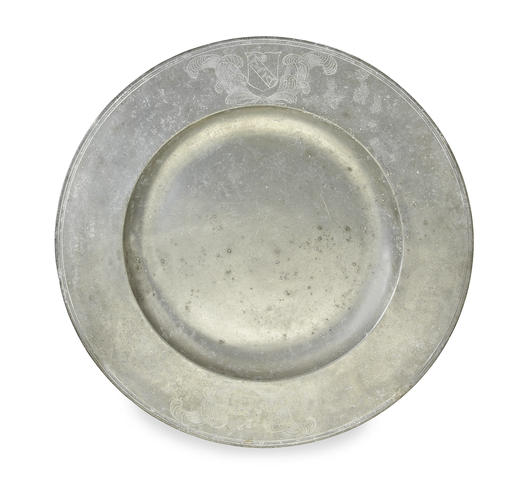
An exceptionally large and rare 17th century reeded broad-rim pewter charger, English, circa 1670. Estimate £6,000-8,000 (€7,500 – 10,000). Photo Bonhams.
The rim engraved with the mantled arms of BORLASE, ermine, on a bend sable, two arms armed issuing out of the clouds argent, rending a horse-shoe or, the augmentation of a baronet being an inescutcheon, a sinister hand erect couped at the wrist and appaumé, within a mantling, and engraved with the mantled crest of BORLASE, on a wreath a wolf passant regardant argent, in the mouth an arrow or, vulning the neck, hallmarks to the front rim of Stephen Lawrance, London, working (1661-1708), (OP5729, PS5729), rim diameter 4 3/4in., 12cm, overall diameter 28 1/2in., 72.4cm, (33%)
Provenance: Engraved with the arms of Sir John Borlase (1619 – 72), first Baronet of Bockmer, Buckinghamshire, or his son Sir John Borlase (1640 – 89), second Baronet.
Ex. Carl Jacobs Collection.
Possibly Ex. Isher Collection.
Literature: Discussed in an article written by Dr Robinson, Journal of the Pewter Society, Vol. 4, No. 2, Autumn 1983, p. 40. It is described as exceptional. A further Journal article, Vol. 28, Autumn 2008, p. 3 – , co-written by Dr. Robinson, lists all current known chargers with a diameter of 23in., or above. This lot is listed as the joint fifth largest example. It remains the largest recorded charger in private hands, and is possibly the largest 17th century pewter charger which has not been altered.
The survey lists the following larger examples:
36 1/8in example in the Fitzwilliam Museum, Cambridge, made by extending the rim of a 29 1/4in charger.
34 3/8in example in the Colonial Williamsburg Museum, Virginia, again possibly made by extending the rim of a smaller charger.
30in 19th century example, whose present whereabouts are unknown, but is noted in an original list made by Dr. Robinson in 1977.
A 19th century oval example, 36in x 23in.
A Romano-British example, the same size as this lot.
The survey records five other chargers by Stephen Lawrance I; diameters 25 1/4in; 23 1/2in and two 23in.
The Borlase Baronets of Bockmer: The baronetcy of Borlase of Bockmer existed from its creation in 1642 to its extinction on the death of the second baronet without an heir in 1689.
The first Baronet, Sir John Borlase, was born at Littlecote House, the son of Sir William Borlase and his wife Amy Popham, daughter of Sir Francis Popham. In April 1640, Borlase was elected Member of Parliament for Great Marlow in the Short Parliament. His re-election as MP for Marlow to the Long Parliament in November 1640 was declared void after a dispute. Instead Borlase was returned as MP for Corfe Castle in 1641. On 4 May 1642, he was created baronet of Bockmer, in the County of Buckingham. He was disabled from sitting for his Royalist tendencies in 1644. In 1645, he was imprisoned by order of Oliver Cromwell, but released for a fine of 2400 £ a year later. After the Restoration, Borlase represented Wycombe in the Cavalier Parliament from 1661 until his death in 1672. Borlase died, aged 52 in Bockmer in Buckinghamshire and was buried in Little Marlow four days later. Borlase married Alice Bancks, daughter of Sir John Bancks, Lord Chief Justice of the Court of Common Pleas, at St Giles in the Fields, London on 4 December 1637. They had seven children, six daughters and one son. He was succeeded in the baronetcy by his only son John.
John Borlase, 2nd Baronet, succeeded his father as Baronet in 1672. In 1673, he entered the House of Commons as MP for Wycombe, representing the constituency until 1681. Borlase died unmarried and was buried in Stratton Audley in Oxfordshire. With his death the baronetcy became extinct.
Both baronets lived at Bockmer in Buckinghamshire, which their family had possessed since the mid-16th century. Their estates included the manor of Stratton Audley, Oxfordshire and Davers in Little Marlow, Buckinghamshire. William Borlase was knighted by James I in 1603, and founded the Borlase School in 1624 as a memorial to his eldest son. Sir John Borlase, First Baronet, was married to Alice (1621 – 1683), eldest daughter of Sir John Bankes. Van Dyck painted her portrait and that of her husband, Sir John. Tradition has it that they entertained Charles II and Nell Gwyn at Bockmer in 1665.

A rare George II yew-wood Cwpwrdd tridarn from North Wales, circa 1730-60. Estimate £5,000-8,000 (€6,300 – 10,000). Photo Bonhams.
Typically in three parts, the open-canopy with baluster-silhouette side slats and baluster-turned column-supports, the middle-section having a triple tablet and pendant-hung frieze, enclosing a pair of recessed flattened ogee-arched cupboard doors later centred by an open mirror-backed recess, over three drawers and a pair of conforming cupboard doors centred by a fixed pointed-arched fielded panel, 144cm wide x 52cm deep x 143cm high, (56 1/2in wide x 20in deep x 56in high)
It is exceptionally rare for a Cypwrdd tridarn to be constructed in yew-wood, rather than using traditional oak. Even the drawer-linings and backboards found here are made in yew.

A rare pair of James I carved and polychrome-decorated oak heraldic finials, circa 1610. Estimate £7,000-10,000 (€8,800 – 13,000). Photo Bonhams.
Each beast modelled as a sejant erect supporter with pricked ears, realistically rendered argent fur with or spots, with delineated ribs and musculature, and erect phallus, seated on a hemisphere, each with tail curved over a haunch, and holding between each paw a scroll-ended cartouche with sunken oval centre, one painted with the coat of arms of WARREN, chequy or and azure, the other lacking paint,51cm high, (2)
These finials – modelled as beasts with square, canine features, and without protruding lower incisors – are not the same as, but bear close relation to, the leopard finials that adorn both the staircase and Great Hall screen at Knole, the home of the Sackvilles in Kent, built between 1605 and 1608, during ‘re-edifying’ works undertaken by Thomas Sackville, 1st Earl of Dorset.
The current decorative scheme of these finials was revealed after the removal of several layers of paint, but it is entirely possible that the paint remaining is not the original. It is thus difficult to determine for whom these finials were made, where they stood or, indeed, exactly which beast they represent. In heraldry, few beasts are tinctured as they are here, with yellow or gold spots [the heraldic tincture or] against white or silver [argent] fur. Leopards, the most likely candidate, are usually tinctured with a non-metallic colour in combination with a metallic one and are often, like the Sackville leopards, more feline in appearance. The panther, more dog-like, is rendered with spots in a variety of colours, and with flames issuing from its mouth and ears.
The painted coat of arms – chequy or and azure – is that of WARREN, earlier DE WARRENE. This family had become extinct by the 17th century, but their coat of arms was quartered by their descendants, most notably the Howards. Thus, chequy or and azure was one of the quarterings of the arms of Anne Boleyn when she was made Marchioness of Pembroke, and her dexter supporter was a leopard. In the later 16th and 17th centuries, the Howard Dukes of Norfolk and the Howard Earls of Surrey and Arundel quartered these arms with their own. If these finials were used as part of a decorative scheme in one of the many Howard properties which were re-modelled or newly built in the 17th century – the most notable of these being Northampton House, Audley End and Arundel House – the other finials would have to have been painted with different quarters, in order for the staircase, taken as a whole, to display the owner’s entire coat of arms. A 19th century Gothic staircase at Arundel Castle, which was razed during the Civil War in 1644, shows different quarters of the Howard arms on different finials. One of them bears the arms of WARREN.

A rare pair of Charles II oak joint stools, Lancashire, circa 1670-80. Estimate £5,000-8,000 (€6,300 – 10,000). Photo Bonhams.
Of elongated form, each seat with thumb-moulded edge, unusually carved to just one long frieze-rail with interlaced and leaf-filled lunettes, the remaining rails all with channel-moulded lower edge, raised on elongated ball-turned and gently splayed legs, joined by plain stretchers, 60.5cm widex 28.5cm deep x 55.5cm high, (23 1/2in wide x 11in deep x21 1/2in high) (2)
Provenance: Each with former stock label which probably refers to H. W. Keil, Broadway, Worcestershire.
Although the majority of joint stools were possibly made in sets of six or more it is now relatively scarce to find more than a single example from a larger set. This pair are rarer still for their elongated proportions and carving to just one frieze-rail. The fine straw-colour, to the underside of the seat and the rear of the frieze-rails should also be noted; a distinctive feature often found on the underside of late 17th century seat furniture from Lancashire and the surrounding areas.








